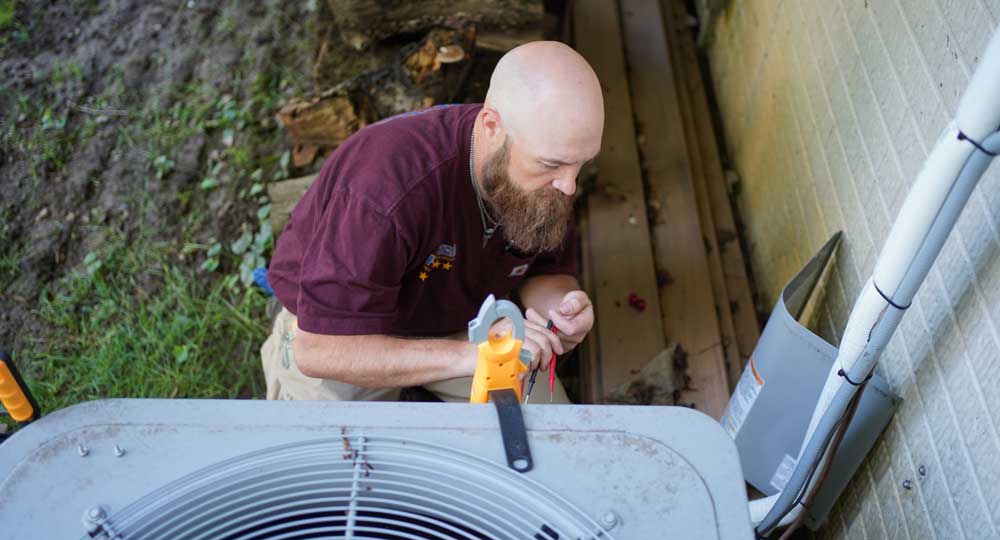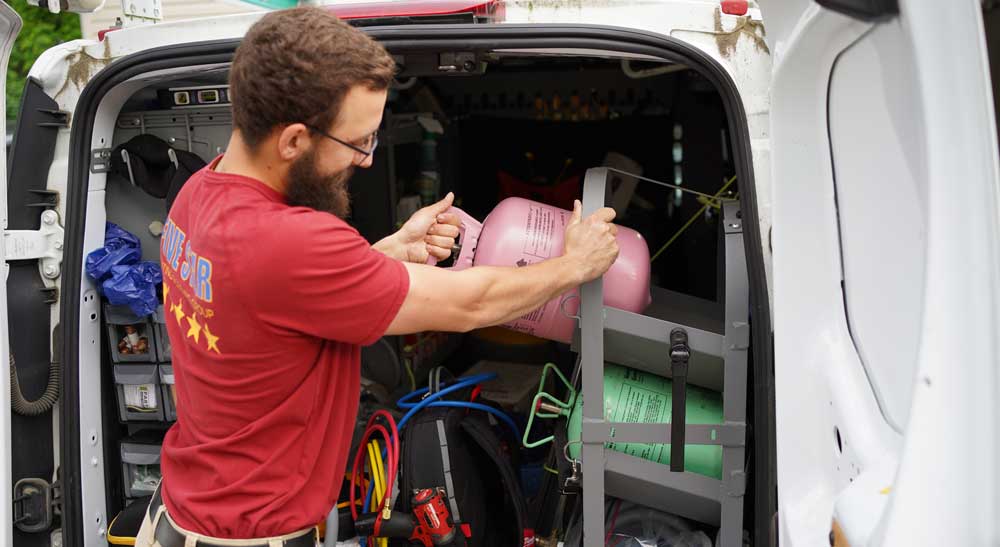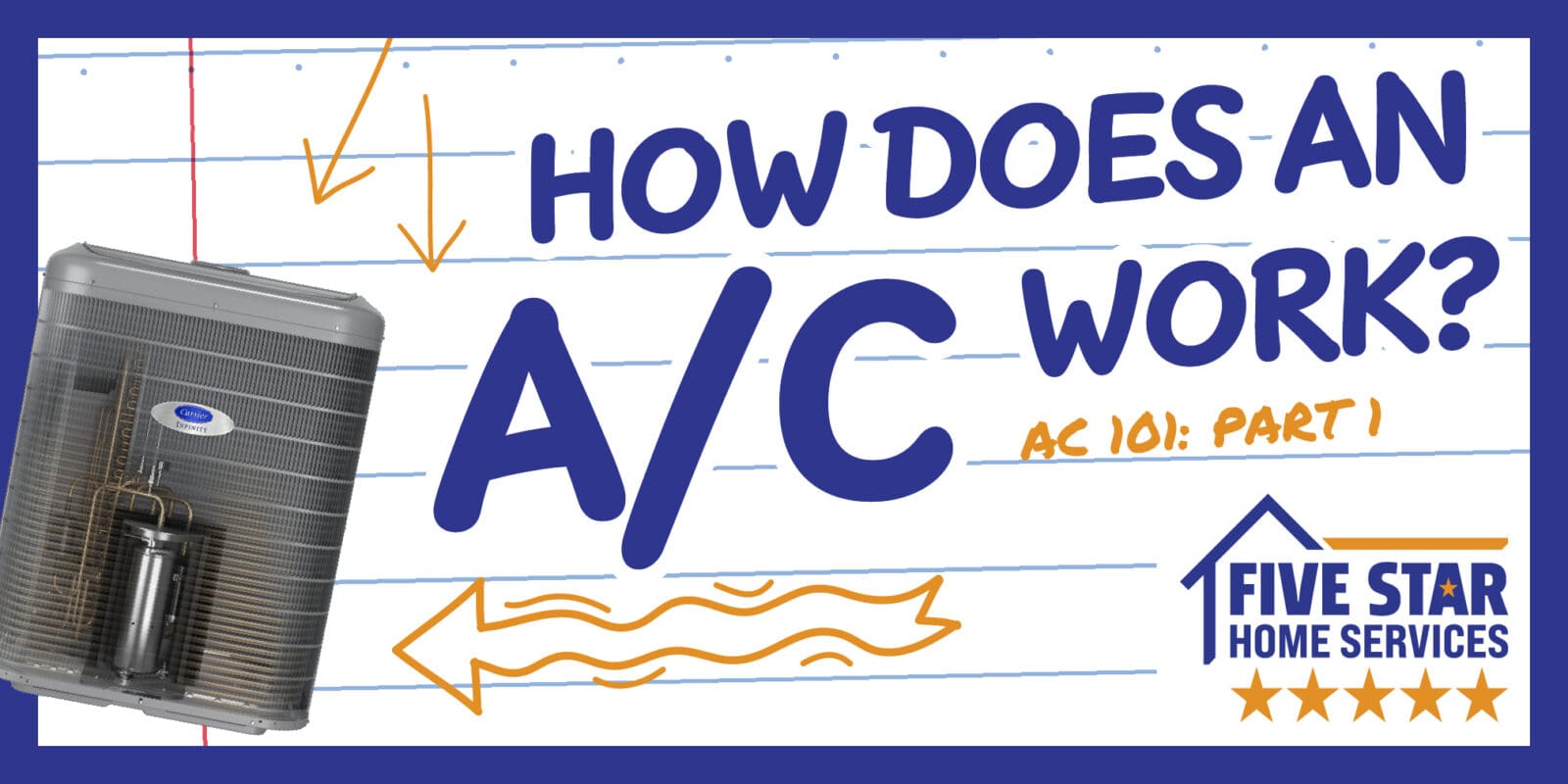Ahhh the joy of central air conditioning!
Many people take this modern luxury for granted. However, when someone loses their cool air and the hot and humid summer keeps them up at night, they gain a new appreciation for this modern invention. Let’s give credit where credit is due!
We all need our A/Cs to work tirelessly throughout the summer months here in Ohio. That’s why we put together this five-part blog series – to keep you informed.

The following is our first installment of this educational series on central air conditioning. Essentially, this series aims to demystify the essentials of residential air conditioning and how it works while giving you real-world insights into the process. We will also look at the history of modern air conditioning and more. We have it all right here!
If you’re a homeowner in Greater Columbus, Dayton, Cincinnati, or surrounding areas, you could benefit from learning more about this. At Five Star Home Services, we believe knowledge is power, and we want our customers and readers to always be informed.
Understanding how our central cooling systems work can help you maintain a more comfortable home and make more informed decisions about repairs or upgrades. Let’s unpack this concept further in the following.
It’s our aim to enlighten you about this amazing modern marvel we all depend on!
The Joys of Central Cooling
For many of us, life without air conditioning is hard to imagine. This is what we mean by taking A/C for granted.
Without A/C, Ohio’s oppressive heat waves can melt the rubber on your shoes and even cook an egg on your car’s dashboard! All jokes aside, a lack of A/C can make it nearly impossible to get a good night’s rest — making life miserable! Not to mention the humidity and discomfort from a lack of climate control during the summer!
It can very easily become too much! It can even pose a risk to your health and safety. Because of this, air conditioning isn’t merely a luxury in Ohio.
Our central air conditioners make our homes cool and comfortable when the heat outside is too much to bear. In the following, we hope to help you learn how your home’s A/C system works to improve its performance and make you feel a lot more confident when the time comes and you need to find a replacement, especially if your AC breaks down during the dog days of summer here in Ohio. However, let’s first look at a brief history of central air conditioning – which goes back to a man named Carrier in the 1900s.

A Brief History of Air Conditioning
Have you ever wondered what life would be like without central cooling systems in our homes and vehicles? Let’s just say it would not be pleasant during summer. In any case, before we dive into the mechanics of AC, let’s take a moment to appreciate the history of this amazing modern appliance.
Although the concept of cooling air dates back to certain ancient civilizations, what they had then was a far cry from what we have today. Modern air conditioning has come a long way. The modern AC goes back to 1902, when a pioneering inventor named Willis Carrier developed the first electrical air conditioner around the turn of the century. Originally, his first line of products was designed to control humidity in a printing plant. But the invention took off. Carrier’s invention, in fact, revolutionized comfort and productivity in both residential and commercial settings. This opened the door for housing developments in previously uninhabitable parts of the world where the summers were too hot. Today, a whole line of products and a company are named after this modern inventor.
So how do they work? We’re glad you asked!
How Central Air Conditioners Work
The Process of Heat Exchange
Central air conditioning systems work at their core by extracting heat from your home and releasing it into the air outside. The entire process, known as heat exchange, involves several essential components. They include the following:
- The Evaporator Coil: This essential component is located inside your home. Usually, it is in your air duct system near your heating system or furnace. Evaporator coils absorb heat from the indoor air. Then, as the warm air passes over the coil, the refrigerant inside the home absorbs the heat, cooling the air, which then gets circulated back into your home.
- The Condenser Coil: This part is located outside the home. Condenser coils release the absorbed heat into the outdoor air. Now carrying the heat, the refrigerant travels from the evaporator coil to the condenser coil, which is cooled and turned back into a liquid.
- The Compressor: AC compressors are the heart of the system. They pump the refrigerant between the evaporator and condenser coils. As the name suggests, they compress the refrigerant, which increases its pressure and temperature before it reaches the condenser coil.
- The Expansion Valve: Expansion valves regulate refrigerant flow into the evaporator coil, ensuring that the right amount of refrigerant is available to absorb heat from the indoor air.

The Role of Air Conditioner Refrigerant
Next, we will explore the role of AC refrigerant. Refrigerants are specialized fluids that constantly cycle through the air conditioning system. They absorb and release heat as it changes from liquid to gas. Common types of AC refrigerants include R-410A and R-22. Remember that the latter, R-22, is being phased out because of various health and environmental concerns. Next, we will look at the operation cycle.

The A/C Operation Cycle
Modern air conditioning systems are complex systems. Their operational cycle is intricate as well; it involves the following steps in order:
- Thermostat Activation: Whenever the temperature inside your home or office rises above what the thermostat is set to, it immediately signals the central cooling system to begin a cooling cycle.
- Air Circulation: Next, the system’s blower motor pulls warm air from your home through return ducts, passing it over the evaporator coil.
- The Cooling Process: As the air passes over the evaporator coil, the AC refrigerant absorbs the heat and moisture, effectively cooling the air. The cool air is then circulated back into your home through your supply ducts.
- The Heat Release: The AC refrigerant, which is now carrying the absorbed heat from the home, travels to the condenser coil. This is where the heat is released into the outdoor air and the process continues.
- Cycle Continuation: Your compressor pumps the refrigerant back to the evaporator coil once it’s done its job. This cycle repeats until the desired indoor temperature is achieved and you enjoy optimal indoor comfort. Your thermostat determines when that temperature is met and when the system needs to run another cycle.
Why Understanding Your System Matters
You might be wondering: Do I really need to know all this?
The answer depends. At Five Star Home Services, we want our customers and readers to have a basic understanding of how their central air conditioning system works because doing so can help you identify potential issues, improve energy efficiency, and prolong the lifespan of your equipment. Knowledge is power, after all. In short, regular maintenance, such as replacing air filters, scheduling professional inspections, and regular AC tune-ups from a professional like us, pays off in the long run!
We can also ensure that your system operates at peak performance for years to come!
Give Us a Call for Personalized, Professional Cooling Solutions
Still need help? If so, you’re in the right place. At Five Star Home Services, we’ve been serving Ohio homeowners for more than 50 years, providing expert HVAC services tailored to meet our customers’ needs. If you have questions about your air conditioning system or need personalized cooling solutions, don’t hesitate to give us a call right away!
You can also learn more about our services or get an instant online estimate. Additionally, you can always reach a friendly live person directly at (833) 405-8009.
📁 Download our 2024 AC Buying Guide ➡️
Stay tuned for the next part of our series, where we’ll explore advanced topics and provide tips for optimizing your home’s cooling efficiency.
We will focus on what homeowners need to know about the installation process. Remember, getting it in right is half the battle. Home cooling systems are complex and require expertise to ensure you get what you’re paying for.

